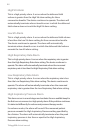Chapter 3 Modes, Features, and Alarms
45
For pressure modes, the alarm occurs when the delivered pressure
exceeds the target patient pressure by 5 cmH
2
O or more during
the inspiratory phase. The device will automatically cycle to
the expiratory phase and continue to operate. The alarm will
automatically terminate when the delivered pressure falls within 5
cmH
2
O of the target patient pressure during the inspiratory phase.
Low Inspiratory Pressure Alarm
This is a high priority alarm. It is detected dierently for volume and
pressure therapy modes.
For volume modes, the alarm will sound if the measured patient
pressure is less than the Low Inspiratory Pressure setting specied by
the clinician. The alarm will automatically terminate when the peak
pressure at the end of the breath is greater than or equal to the Low
Inspiratory Pressure alarm setting.
For pressure modes, the alarm occurs when the delivered pressure
is 5 cmH
2
O or more below the target patient pressure during the
inspiratory phase. The alarm will automatically terminate when
the delivered pressure comes within 5 cmH
2
O of the target patient
pressure during the expiratory phase.
High Minute Ventilation Alarm
This alarm is a high priority alarm. It occurs when the patient’s
minute ventilation is greater than the High Minute Ventilation alarm
setting. The device continues to operate. The alarm will automatically
terminate when the calculated minute ventilation is less than the
High Minute Ventilation alarm setting.
Low Minute Ventilation Alarm
This alarm is a high priority alarm. It when the patient’s minute
ventilation is less than the Low Minute Ventilation alarm setting. The
device continues to operate. The alarm will automatically terminate
when the calculated minute ventilation is greater than the Low
Minute Ventilation alarm setting.


















